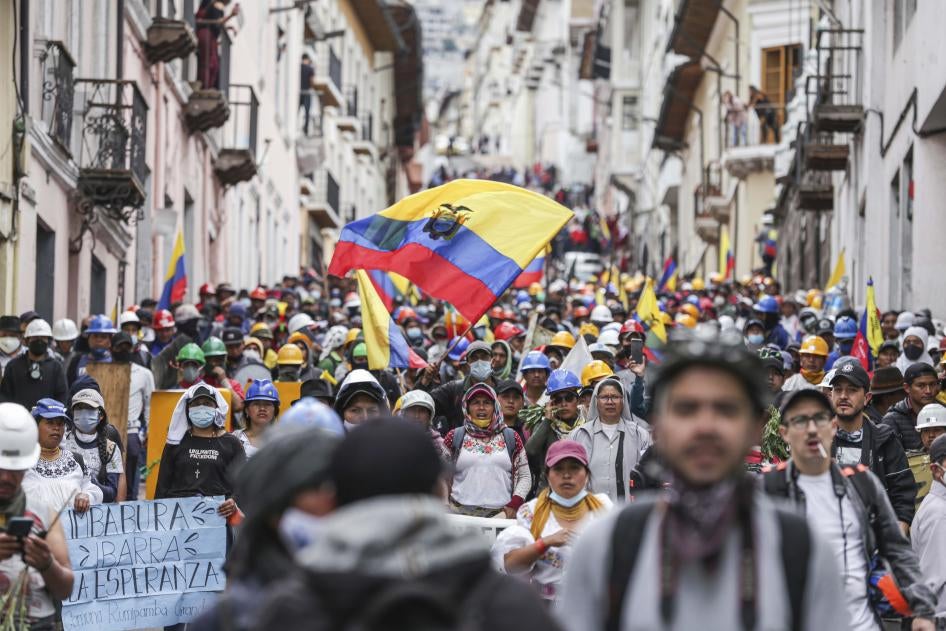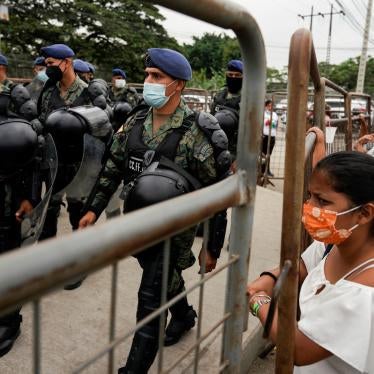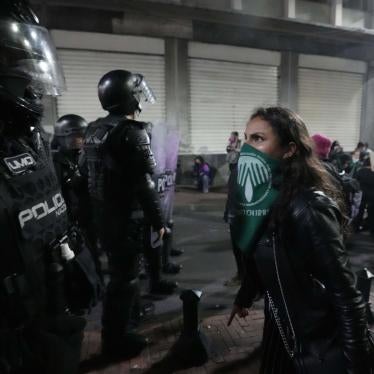The June anti-government protests in Ecuador and their images of violence and police abuse evoked a sad sense of déjà vu that recalled protests from 2015, 2019, and 2020. But this time authorities should demonstrate that they are serious about addressing structural problems, ensuring accountability for abuses by security forces, and preventing waves of looting and vandalism.
On June 30, government authorities and Indigenous leaders reached an agreement after several days of unrest to stop protests that began on June 13. Indigenous organizations led by the Confederation of Indigenous Nationalities of Ecuador, known by its Spanish acronym CONAIE, had called for protests in response to what they deemed the government’s lack of will to address their demands.
Among other measures, Indigenous groups have asked the authorities to guarantee Indigenous peoples’ collective rights; to intervene to lower the prices of food and other essential goods; ensure Indigenous people’s access to health, education, and employment; and repair the social and environmental impacts of mining and oil extraction in Indigenous territories.
These are long-standing debts. Although Ecuador’s constitution and international law recognize Indigenous peoples’ rights—including to prior consultation on mining and oil projects affecting their territories—United Nations experts have found “persistent gaps” in enforcement. Indigenous communities are typically located in rural areas, where the percentage of people living in poverty is double that of people in urban areas. Poverty contributes to the lack of access to basic services, including health care. According to government statistics, half as many people in rural areas are adequately employed—earning at least minimum wage—compared with urban areas.
It is critical for authorities, in the longer term, to show a genuine commitment to prioritizing Indigenous rights, including by ensuring that communities have a voice in the protection of their rights and land. They should also ensure prompt, thorough, and impartial criminal investigations of police implicated in excessive force and crimes committed by others in the context of the protests. Between pardons and cases that languished until the statute of limitations closed them, prosecutions of both sides after past demonstrations have proved inadequate.
The protests, which began peacefully, evolved into abhorrent violence. Some people—who allegedly infiltrated the protests—looted and vandalized private and public property and blocked the delivery of medicines and oxygen to hospitals, government authorities said. Some protesters attacked security forces and journalists covering the demonstrations. Over 200 police were injured and 37 held captive by protesters for several hours, according to the National Police. These actions go way beyond the right of peaceful assembly protected under international law.
On several occasions, police responded with excessive force, shooting teargas canisters directly at demonstrators or close to areas sheltering children and injured people. Five civilians and one member of the military died and over 300 people have been injured, according to local human rights groups. In one of the cases, the government confirmed that the victim had been hit by a teargas canister.
Police have the responsibility to protect Ecuadoreans from violence. But authorities are also required to respect the right of peaceful assembly and to ensure that police use force only as strictly necessary and proportionate, in a manner that is consistent with the law, and commensurate to the threats to other people’s rights. The authorities should also stop deploying military forces for crowd control. As we’ve seen in Latin America, excessive use of force frequently triggers further unrest.
As we watched the violence and abuse unfold, we recalled what happened during anti-government protests in August 2015 and October 2019, and during peaceful demonstrations against the government’s handling of the Covid-19 pandemic in May 2020.
Every time, the protests began with legitimate asks.
Every time, violence erupted, whether by protesters or alleged infiltrators.
Every time, evidence of police abuse surfaced.
Every time, impunity prevailed.
And every time, authorities found a way to put out the fire—sometimes literally—without addressing the underlying problems that had led to the protests.
This time, authorities can break Ecuador’s cycle of violence and abuse at anti-government protests by addressing the root causes that brought people to the streets.
The government has taken initial steps, such as reducing fuel prices, increasing the budget for intercultural education, declaring a health emergency that would expedite the purchase of medicines and medical supplies for everyone, and committing to changing legislation related to mine and oil exploitation affecting Indigenous territories.
The agreement reached by both sides at the end of June includes a commitment to sit down at the table to address the demands that led to the protests. If conducted effectively and honestly, the current dialogue has the potential to help Ecuador address problems that have long undermined the rights of peaceful protesters and of people excluded from government protection and support.










